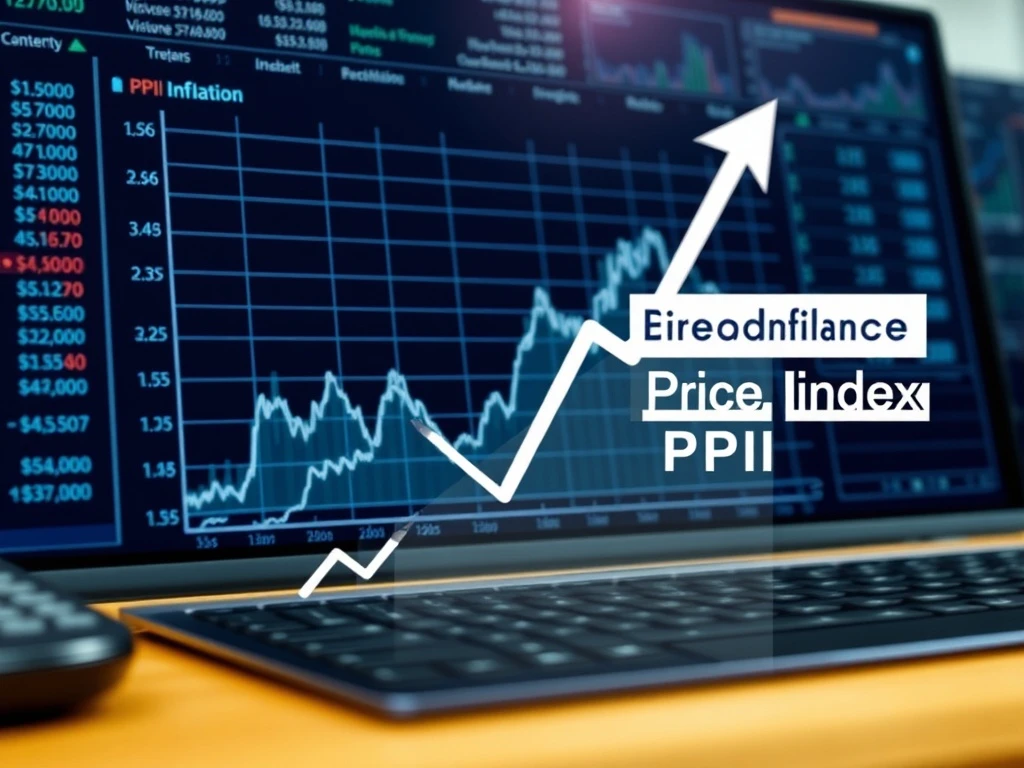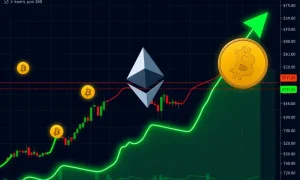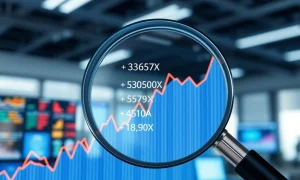Many investors focus intently on the Consumer Price Index (CPI) as the primary gauge of inflation. However, savvy market participants know that CPI, while important, often reflects past conditions. It can be a lagging indicator. For a truly proactive approach to market trends and inflation, smart investors are now shifting their attention. They understand that another vital metric provides earlier, more potent signals. This crucial economic indicator is the **Producer Price Index** (PPI).
Understanding the nuances of economic data is paramount for making informed investment decisions. While CPI captures the cost of goods and services for consumers, it doesn’t always tell the full story. In fact, relying solely on CPI might lead to delayed reactions in volatile markets. This article will explore why the **Producer Price Index** offers a more insightful, forward-looking perspective on inflationary pressures, empowering you to navigate economic shifts with greater confidence.
The Limitations of Relying Solely on CPI Data
The Consumer Price Index (CPI) tracks the average change over time in the prices paid by urban consumers for a market basket of consumer goods and services. Governments and central banks widely use it. Investors often monitor CPI for signs of inflation or deflation. However, CPI has inherent limitations. First, it is a backward-looking measure. It reflects price changes that have already occurred. This means investors react to events rather than anticipating them.
Furthermore, the CPI basket of goods and services can be slow to adapt. It may not always capture rapid shifts in consumer spending habits. Critics also point to methodological adjustments, which can sometimes create a perception of ‘manipulation.’ While official bodies aim for accuracy, these adjustments can lead to skepticism. For instance, the treatment of housing costs or the substitution effect can alter reported figures. Therefore, investors seeking a clearer, more predictive signal must look beyond CPI. They need an indicator that captures inflationary pressures at their source.
Understanding the Producer Price Index (PPI)
The **Producer Price Index** (PPI) measures the average change over time in the selling prices received by domestic producers for their output. In simple terms, it tracks the prices that businesses receive for their goods and services. This differs significantly from CPI, which measures prices paid by consumers. PPI captures price changes at various stages of production. These stages include raw materials, intermediate goods, and finished goods.
The Bureau of Labor Statistics (BLS) compiles and releases PPI data monthly. It offers a comprehensive look at producer-level inflation. This index is critical because it reflects input costs for businesses. When these costs rise, businesses often pass them on to consumers. This makes PPI a leading indicator for consumer inflation. It provides an early warning system for potential price hikes in the retail sector. Monitoring the **Producer Price Index** gives investors a crucial edge.
 Understanding the flow of prices from producers to consumers is vital for market analysis.
Understanding the flow of prices from producers to consumers is vital for market analysis.
Why the Producer Price Index is a Critical Economic Indicator
The **Producer Price Index** serves as a vital barometer for future inflation. Its significance stems from its position in the economic supply chain. Businesses face rising costs for their inputs long before consumers see higher prices at the checkout. Consider these key reasons why PPI is so important:
- Leading Indicator: PPI often signals future changes in CPI. Higher producer costs typically translate into higher consumer prices. This process happens as businesses seek to maintain profit margins.
- Corporate Profit Margins: Rising PPI without a corresponding increase in consumer demand can squeeze corporate profits. This directly impacts stock valuations and investor returns.
- Supply Chain Insights: PPI provides granular data on specific industries and commodities. This offers insights into where inflationary pressures are building within the supply chain. Investors can then identify vulnerable or resilient sectors.
- Monetary Policy Clues: Central banks, including the Federal Reserve, closely monitor PPI. They use it to gauge underlying inflationary trends. PPI data can influence their decisions on interest rates and quantitative easing.
Therefore, tracking the **Producer Price Index** allows investors to anticipate economic shifts. It enables more timely adjustments to investment portfolios.
The Interplay: PPI, CPI, and Inflationary Pressures
The relationship between the **Producer Price Index** and the Consumer Price Index is crucial. PPI often acts as a precursor to CPI. Imagine a factory producing widgets. If the cost of raw materials (captured by PPI) increases, the factory faces higher production expenses. To maintain profitability, the factory must eventually raise the selling price of its widgets. This increase then filters down to retailers. Ultimately, consumers pay more (reflected in CPI).
This transmission mechanism is not always immediate or one-to-one. However, a sustained rise in PPI almost invariably puts upward pressure on CPI. Conversely, falling PPI can signal disinflation or even deflation. This gives businesses room to lower prices. Investors must monitor both indices. However, PPI provides the earlier signal. It highlights cost-push inflation, where rising input costs drive prices up. This differs from demand-pull inflation, where strong consumer demand pushes prices higher. Understanding this interplay offers a more complete picture of the inflationary landscape.
Investor Implications: Navigating Economic Indicators
For investors, understanding the **Producer Price Index** is not merely an academic exercise. It has direct implications for portfolio management. When PPI shows persistent increases, investors should consider several strategies:
- Sector Rotation: Industries with high input costs, like manufacturing or construction, might face margin compression. Conversely, sectors less reliant on volatile commodities, or those with strong pricing power, might perform better. Examples include technology or healthcare.
- Inflation Hedges: Rising PPI can signal broader inflation. Investors might consider inflation-protected securities (TIPS), real estate, or commodities. These assets often perform well during inflationary periods.
- Corporate Earnings Forecasts: Analyze company earnings reports with PPI in mind. Look for companies that have successfully managed input cost increases. Also, identify those that have passed costs to consumers without losing market share. This indicates strong pricing power.
- Monetary Policy Expectations: Higher PPI readings can prompt central banks to adopt more hawkish monetary policies. This includes raising interest rates. Such actions can impact bond yields, equity valuations, and currency strengths. Investors should adjust their expectations accordingly.
Therefore, incorporating **Producer Price Index** analysis into your investment framework provides a distinct advantage. It moves you from reactive to proactive.
Beyond the Headlines: A Deeper Look at Economic Indicators
While the **Producer Price Index** offers a powerful lens, a truly comprehensive investment strategy considers a range of economic indicators. No single data point tells the whole story. For example, wage growth, as measured by the Employment Cost Index (ECI), indicates labor market tightness and potential cost-push inflation from wages. Retail sales data offers insights into consumer demand. Purchasing Managers’ Indexes (PMI) for manufacturing and services sectors provide a snapshot of economic activity and business sentiment.
However, PPI holds a unique position. It directly addresses the cost side of the equation for businesses. This makes it a crucial early warning system. By combining insights from PPI with other relevant data, investors build a robust framework. They gain a clearer understanding of economic forces. This allows them to make more resilient investment choices. Ultimately, a holistic approach to economic data empowers better decision-making.
Conclusion: PPI as Your Foremost Economic Indicator
In conclusion, while the Consumer Price Index remains a widely reported measure of inflation, its backward-looking nature limits its utility for proactive investors. The **Producer Price Index**, however, offers a more dynamic and forward-looking perspective. It tracks the fundamental costs faced by businesses. This makes it an invaluable tool for anticipating inflationary pressures. By closely monitoring PPI, investors can gain a crucial edge. They can better understand the trajectory of prices. They can also make more informed decisions about their portfolios. Move beyond mere reaction. Embrace the predictive power of the **Producer Price Index** to navigate the complex economic landscape.
Frequently Asked Questions (FAQs)
What is the Producer Price Index (PPI)?
The Producer Price Index (PPI) measures the average change over time in the selling prices received by domestic producers for their output. It tracks prices at various stages of production, from raw materials to finished goods, before they reach consumers.
How does PPI differ from CPI?
PPI measures prices from the perspective of the seller (producer), reflecting their input costs and selling prices. Conversely, the Consumer Price Index (CPI) measures prices from the perspective of the buyer (consumer), tracking the cost of a basket of consumer goods and services.
Why is the Producer Price Index considered a leading indicator for inflation?
PPI is a leading indicator because increases in the costs of production for businesses often get passed on to consumers in the form of higher retail prices. This process usually occurs with a time lag, making PPI a signal for future consumer inflation.
How do investors use PPI data?
Investors use PPI data to anticipate future inflation trends, assess potential impacts on corporate profit margins, identify which sectors might be affected by rising input costs, and gauge the likelihood of central bank monetary policy changes. It helps them make strategic investment decisions.
What other economic indicators should investors watch alongside PPI?
While PPI is critical, investors should also monitor other indicators. These include the Employment Cost Index (ECI) for wage inflation, retail sales for consumer demand, and Purchasing Managers’ Indexes (PMI) for overall economic activity. A comprehensive view is always best.








